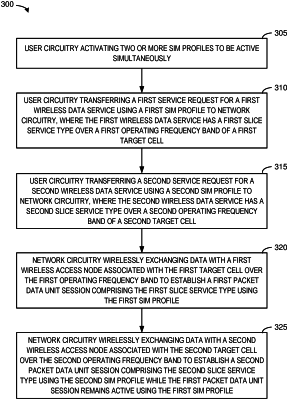| CPC H04W 8/205 (2013.01) [H04W 36/08 (2013.01); H04W 36/32 (2013.01); H04W 48/18 (2013.01)] | 20 Claims |

|
1. A method of operating a wireless User Equipment (UE) to utilize multiple subscriber identity module (SIM) profiles, the method comprising:
user circuitry activating two or more SIM profiles to be active simultaneously;
the user circuitry transferring a first service request for a first wireless data service using a first SIM profile of the two or more SIM profiles to network circuitry, the first wireless data service having a first slice service type over a first operating frequency band of a first target cell;
the user circuitry transferring a second service request for a second wireless data service using a second SIM profile of the two or more SIM profiles to the network circuitry, the second wireless data service having a second slice service type over a second operating frequency band of a second target cell wherein the first operating frequency band is selected based on the first slice service type and the second operating frequency band is selected based on the second slice service type;
the network circuitry wirelessly exchanging data with a first wireless access node associated with the first target cell over the first operating frequency band to establish a first packet data unit session comprising the first slice service type using the first SIM profile; and
the network circuitry wirelessly exchanging data with a second wireless access node associated with the second target cell over the second operating frequency band to establish a second packet data unit session comprising the second slice service type using the second SIM profile while the first packet data unit session remains active using the first SIM profile.
|